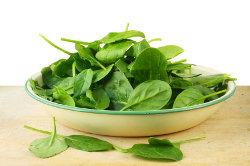Top 5 Healthy Dark Green Vegetables

Take a look at Popeye and his spinach. He would down a can and practically lift a car. Impressive wasn’t it? Maybe the general idea isn’t so far fetched.
Five of the healthiest dark green vegetables include broccoli, kale, spinach, romaine lettuce and Swiss chard. These vegetables, identified by their dark green color, are rich in antioxidants and usually have large amounts of phytochemicals like Vitamin C.
Many foods tend to lose nutrients when cooked. The great thing about these dark green vegetables is that you can find them easily in your grocery store and they taste great with little or no cooking, leaving much of their nutrients intact. Here is some important information about these healthy veggies:
Broccoli is a fun vegetable for kids because it feels like you’re eating a small tree. In fact, the little buds are actually tiny flowerettes and 1 cup of of broccoli contains as much Vitamin C as one small orange.
Some facts about broccoli you may not already know include:
- Broccoli is a great source of fiber, both soluble and insoluble. It not only meets both types of fiber needs, but it’s also a rich source to add to your diet.
- Research has shown indole-3-carbinol - found in the phytonutrients of broccoli - actually deactivates a metabolite which can become cancerous.
- Broccoli also helps restore sun-damaged skin, reduces the risk of heart disease, and boosts the immune system. At the same time, it also promotes healthy bone growth due to its massive amounts of calcium.
Kale is a slightly bitter, leafy green with a huge amount of folic acid and potassium. Try some kale in your stir-fry. You may just find yourself thoroughly impressed.
- The folic acid found in kale is a great addition to your diet if you suffer from poor hair, skin and nails.
- In addition, the potassium helps to promote the breakdown of lactic acid in muscles after a workout, and is a great food to help prevent muscle soreness in the recovery process.
Swiss chard is similar to spinach, with a little more of an earthy undertone. Rich in Vitamins C and K, as well as calcium, Swiss chard is a great addition to salads.
- Vitamin K helps promote healthy eye and brain function. The next time you have to spend hours staring at a computer screen or studying for that big exam, try some Swiss chard and let your mind be at ease knowing your brain is getting the nutrients it needs.
Spinach is a lean mean green antioxidant-packing machine, rich in flavor and in Vitamins A and C, and iron.
- Spinach is loaded with important vitamins and minerals to promote healthy brain function as well as strong bones and muscles.
- Next time you have a salad, try it with spinach instead of lettuce for a little variety and a big explosion of taste.
You can also add spinach into meals like scrambled eggs, pasta sauces or into a sandwich.
Opt for baby spinach for a lighter taste!
Lettuce may be the last thing that comes to mind when you picture dark green vegetables. While many of the lighter shades of lettuce, such as iceberg, have very little nutritional value, the darker the color, the more they have to hide.
Romaine lettuce, while still made up mostly of water, is packed with antioxidants and fiber.
The darker green the leaf, the more folic acid is present, which prevents heart disease.
Even though lettuce seems so simple, look at some of its complex attributes:
- Lettuce is great for diets since it’s very low in calories.
- Magnesium, found in romaine lettuce, does wonders in revitalizing muscular tissues, the brain and the nerves.
- The chlorophyll-packed juice in lettuce is very helpful in maintaining normal hair color.
- Lettuce is high in iron, which helps the formation of red blood cells.
- Lettuce may help in treating insomnia, acid indigestion, colitis, constipation, gout, stress and many other diseases as well.
While you might have been forced to eat your dark green veggies as a kid, now you know why it was so important. Even today, your dark greens are vital to your health and well-being. Try these dark greens in some new recipes; you just might surprise yourself and actually enjoy it!
How many of these dark green vegetables do you eat? How often?
Must Read
Vitamins & Minerals RDA Calculator
Top 7 Healthy Orange Fruits and Vegetables
How to Get More Veggies into Your Diet to Lose Weight
7 Things You Need to Know About Serving Sizes
